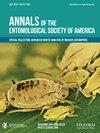使用RNA干扰方法鉴定导致犀圆线虫(Scarabaeidae:Coleoptera)高死亡率的基因:对大型入侵昆虫的意义
IF 1.8
3区 农林科学
Q1 ENTOMOLOGY
引用次数: 2
摘要
摘要椰子犀甲虫Oryctes rhinoceros(L.,1758)是一种原产于东南亚的大型金龟子甲虫,是其入侵范围内椰子(Cocos nucifera)和油棕榈(Elaeis guineensis)的主要害虫。很少有工具可用于椰子犀甲虫管理,特别是对于一种新出现的单倍型,该单倍型对已知的Oryctes犀裸病毒株具有耐药性,Oryctes犀牛裸病毒株是椰子犀甲壳虫管理计划中使用的传统生物控制剂。RNA干扰(RNAi)是一种新兴的害虫控制工具,它利用靶生物中现有的基因调控途径。在这项研究中,我们评估了RNAi作为椰子犀牛甲虫管理的潜在工具。利用从初龄幼虫肠道组织中产生的转录组数据,我们确定了24个RNAi靶序列,这些序列在其他昆虫系统中高度表达或已证明有效。其中23个靶序列产生了长度为249至297bp的双链(ds)RNA,并将150ng微注射到椰子犀甲虫1、2和3龄幼虫和成虫中。其中五种dsRNA靶向假定编码V型ATP酶、聚腺苷酸结合蛋白和三种形式的肌动蛋白的基因,在注射后14天内诱导30.8-100%的死亡率(dpi)。用10和100 ng这五种相同的dsRNA微注射2龄幼虫,在7和14 dpi时分别诱导20-100%和80-100%的死亡率。这些结果表明,RNAi应该被探索作为椰子犀甲虫的一种可能的管理选择。椰子犀甲虫也可能是利用RNAi管理大型入侵昆虫物种的模式物种。本文章由计算机程序翻译,如有差异,请以英文原文为准。
Identification of Genes That Result in High Mortality of Oryctes rhinoceros (Scarabaeidae: Coleoptera) When Targeted Using an RNA Interference Approach: Implications for Large Invasive Insects
Abstract Coconut rhinoceros beetle, Oryctes rhinoceros (L., 1758), is a large scarab beetle native to Southeast Asia and a major pest of coconut (Cocos nucifera) and oil (Elaeis guineensis) palms in its invaded range. Few tools are available for coconut rhinoceros beetle management, particularly for an emerging haplotype with resistance to known strains of Oryctes rhinoceros nudivirus, the traditional biological control agent used in coconut rhinoceros beetle management programs. RNA interference (RNAi) represents an emerging tool for insect pest control that exploits an existing pathway for gene regulation in the target organism. In this study, we evaluated RNAi as a potential tool for coconut rhinoceros beetle management. Using transcriptome data generated from gut tissue of early instar larvae, we identified 24 RNAi target sequences that were either highly expressed or had demonstrated efficacy in other insect systems. Double-stranded (ds)RNAs ranging from 249 to 297 bp in length were generated for 23 of these target sequences and 150 ng were microinjected into coconut rhinoceros beetle 1st, 2nd, and 3rd instar larvae and adults. Five of these dsRNAs that targeted genes putatively encoding V-type ATPase, polyadenylate binding protein, and three forms of actin induced 30.8–100% mortality within 14 days post injection (dpi). Microinjection of 2nd instars with 10 and 100 ng of these same five dsRNAs induced 20–100% and 80–100% mortality at 7 and 14 dpi, respectively. These results indicate RNAi should be explored as a possible management option for coconut rhinoceros beetle. Coconut rhinoceros beetle may also represent a model species for using RNAi in the management of large invasive insect species.
求助全文
通过发布文献求助,成功后即可免费获取论文全文。
去求助
来源期刊
CiteScore
4.90
自引率
0.00%
发文量
25
审稿时长
6-12 weeks
期刊介绍:
The Annals of the Entomological Society of America exists to stimulate interdisciplinary dialogue across the entomological disciplines and to advance cooperative interaction among diverse groups of entomologists. It seeks to attract and publish cutting-edge research, reviews, collections of articles on a common topic of broad interest, and discussion of topics with national or international importance. We especially welcome articles covering developing areas of research, controversial issues or debate, and topics of importance to society. Manuscripts that are primarily reports of new species, methodology, pest management, or the biology of single species generally will be referred to other journals of the ESA. The most important criteria for acceptance are quality of work and breadth of interest to the readership.

 求助内容:
求助内容: 应助结果提醒方式:
应助结果提醒方式:


